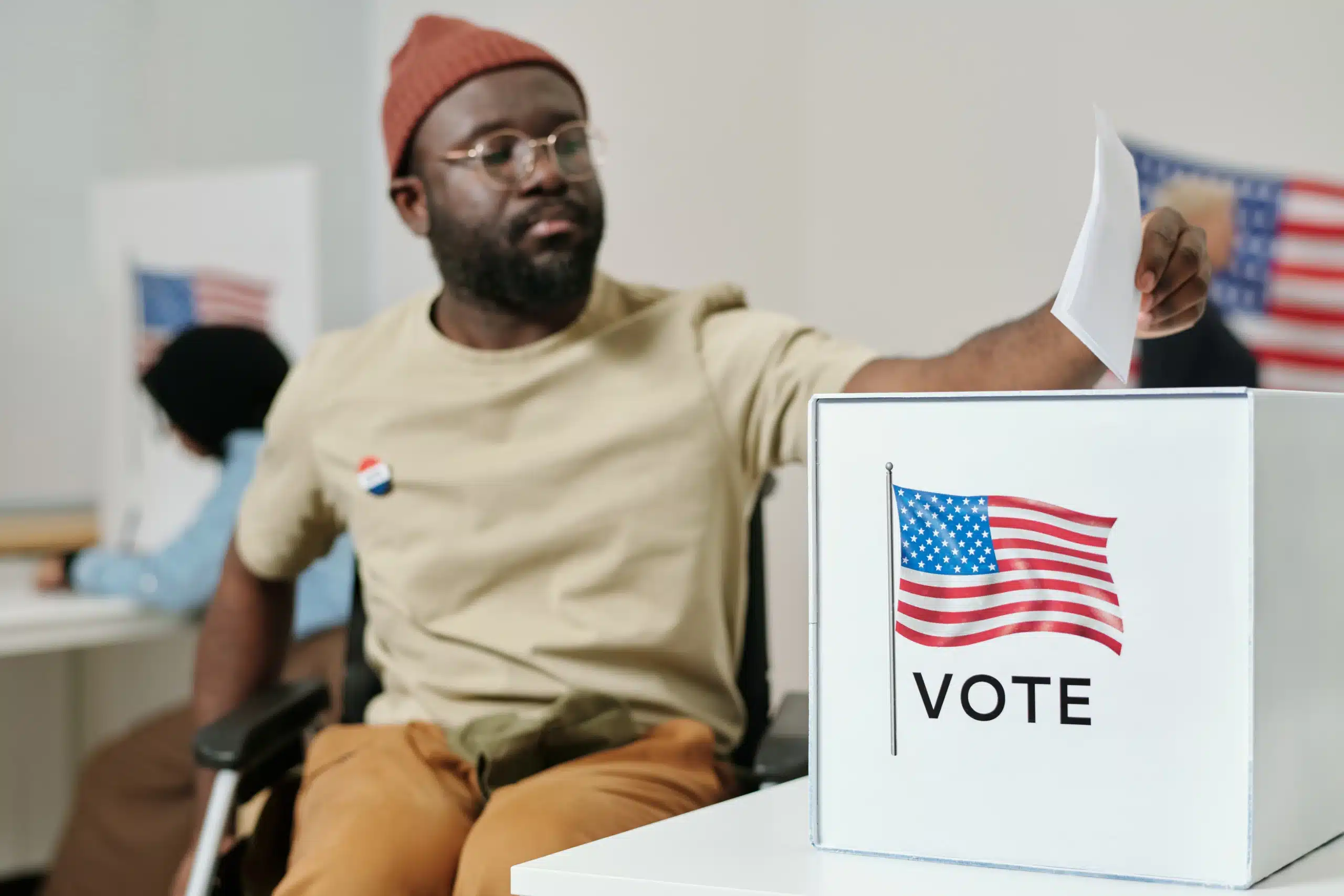Key Takeaways
RECENT POSTS
Categories
Empowering Voters with Disabilities: Navigating the 2024 Election
Key Takeaways
As the United States gears up for another pivotal election year, it's crucial to recognize and uphold the voting rights of all citizens, including those with disabilities. For some, it's the first presidential election after reaching eligibility and navigating the process with a disability they've lived with since birth. For others, it's a new chapter, adjusting to recent changes in their physical abilities and wondering how these changes will impact their ability to participate in an election.
This article serves as a bridge, connecting you to the information and resources essential for a smooth and confident voting experience. It's about ensuring that no matter your situation, your voice is heard and your vote counts in the upcoming election.
Who Can Vote In the United States?
Under Federal law, individuals can vote in U.S. federal, state, and local elections if:
They are a U.S. Citizen
Are 18 years old on or before Election Day
Meet their state residency requirements
Are registered to vote by your state’s voter registration deadline
In American democracy, voting is a fundamental right, and it's generally illegal for states, poll workers, election officials, or service providers to deny a qualified individual the right to vote. This includes protections for individuals with disabilities, including psychiatric or mental disabilities. However, the specific definition of 'qualified individual' can vary by state and may depend on state laws regarding competence to vote.
The general principle under federal law is that if an individual is competent enough to express a desire to vote, whether at the polls or through absentee voting, they should be allowed to do so. Any restrictions on this right, especially based on mental or psychiatric disabilities, must comply with these federal protections and be carefully scrutinized to ensure they don't unjustly discriminate against eligible voters.
What Qualifies as a Disability When Voting?
In the context of voting, a disability is defined in line with the Americans with Disabilities Act (ADA) as any physical or mental impairment that substantially limits one or more major life activities, including voting. This includes a broad spectrum of conditions that can impede the voting process:
Mobility Impairments: Conditions like paralysis, muscle weakness, arthritis, or amputation may make it challenging to stand in lines or access a polling booth without assistance.
Visual Impairments: Including blindness or low vision, these impairments can make it difficult to read a ballot or navigate a polling place without specialized equipment or assistance.
Hearing Impairments: Deafness or difficulty in hearing that can hinder communication with polling place workers or understanding auditory instructions in the voting process.
Cognitive or Neurological Disabilities: Conditions like traumatic brain injury, dementia, or developmental disabilities, which might affect memory, decision-making, or understanding of the voting process.
Psychiatric Disabilities: Mental health conditions like severe anxiety, depression, or PTSD, which might make the experience of voting in a public place overwhelming.
Speech Impairments: Disabilities that affect speech and communication, which might require alternative communication methods or assistance in expressing voting choices.
It's important to note that disabilities for voting purposes are not limited to permanent conditions; temporary disabilities are also taken into consideration. The key factor is whether the condition affects the individual's ability to participate in the voting process without additional accommodations.
A History of Voting Rights in America
For individuals with disabilities, knowing and understanding their voting rights is the first step towards empowered participation in elections. The legal landscape in the United States has several key legislations designed to protect and facilitate the voting rights of disabled individuals.
Key Legislation:
Voting Rights Act of 1965: This legislation includes provisions that allow individuals with disabilities to receive assistance from a person of their choosing (other than an employer or union representative) when voting.
Voting Accessibility for the Elderly and Handicapped Act of 1984 (VAEHA): VAEHA requires accessible polling places for federal elections for elderly individuals and people with disabilities, or alternative means of casting ballots on election day. It also mandates that voter registration and voting aids, such as instructions and information, be provided in accessible formats.
Americans with Disabilities Act (ADA) of 1990: This act ensures that all polling places are accessible to people with disabilities. It requires accommodations such as ramps, wide entrances, and accessible voting booths, enabling individuals with physical disabilities to vote independently and privately.
National Voter Registration Act of 1993 (NVRA): Also known as the "Motor Voter Act," this law enhances the accessibility of voter registration. It requires states to offer voter registration opportunities at all offices providing public assistance, including those offering state-funded programs for persons with disabilities. This act also mandates the availability of mail-in voter registration applications, increasing accessibility for individuals who may find it difficult to register in person.
Help America Vote Act (HAVA) of 2002: HAVA mandates that each polling place have at least one voting system accessible to people with disabilities, including those who are blind or have low vision. This ensures that they can vote privately and independently.
These federal laws collectively create a more inclusive and accessible voting environment, ensuring that the rights of all citizens, including those with disabilities, are protected and facilitated in the electoral process.

Understanding Your Voting Rights
Federal law in the United States sets a standard for what all voting facilities must provide to ensure accessibility for people with disabilities. However, it's important to note that individual states may have additional laws that further support voters with disabilities. Voters with disabilities can anticipate various accommodations and services at voting facilities, all aimed at ensuring a barrier-free and accessible voting experience.
Voter registration has been made more accessible, allowing individuals to register at various public assistance offices, which often cater to those with disabilities. Additionally, mail-in registration options are available, offering an alternative for those who may find in-person registration challenging.
To register to vote, individuals can visit usa.gov/register-to-vote for information to register online, by mail, or in person at their local election office.
Accessible voting methods and aids are fundamental in ensuring an inclusive electoral process for individuals with disabilities. Federal law mandates that all polling places must have at least one accessible voting machine per location for federal elections. These machines are specifically designed to accommodate a broad spectrum of disabilities. They come equipped with features tailored to various needs, including those related to vision, hearing, and mobility. For instance, machines may offer audio instructions for the visually impaired, tactile buttons for those with motor skill challenges, and clear visual displays for individuals with hearing impairments.
In addition to accessible voting machines, a range of voting aids in various formats is available to cater to different needs. This includes voting information, instructions, and ballots in formats like braille, large print, and audio. These aids ensure that voters who have visual impairments or other reading difficulties can access the necessary information with ease. The availability of such diverse formats signifies a commitment to ensuring that all voters, regardless of their disabilities, can participate fully and independently in the voting process. These accommodations are integral to upholding the principles of equality and accessibility in elections, ensuring that every voter has the tools and resources needed to cast their ballot confidently.
All polling places, including those set up temporarily for elections, are required to be physically accessible to ensure that voters with disabilities can participate in the electoral process. These temporary polling stations can be located in a variety of community spaces such as libraries, schools, community centers, fire stations, churches, shops, businesses, or other suitable locations. Regardless of their primary function, these venues, when serving as polling places, are expected to meet accessibility standards.
This includes providing ramps for wheelchair users and ensuring there's enough space within the polling area to accommodate voters who use mobility aids or require additional assistance. These requirements are in place to make sure that all voters, regardless of their physical abilities, have equal access to vote.
Voters who require assistance due to a disability or literacy challenges have the right to bring a person of their choice to help them cast their vote. This assistance is an important accommodation to ensure that all voters can participate in the electoral process. The chosen assistant can be anyone the voter trusts, provided they are not the voter's employer or a representative of their union, ensuring an unbiased and independent voting experience.
Service Animals are an integral part of accessibility for many voters with disabilities. Under federal law, these voters are permitted to bring their service animals, typically trained dogs, into polling places.
These service dogs are essential in providing support and assistance during the voting process. For instance, a service dog might guide a visually impaired voter through the polling station, or help a voter with a physical disability by retrieving items or opening doors. Their presence ensures that voters with disabilities can navigate the voting environment more independently and comfortably.
Election workers receive training to better understand and meet the needs of voters with disabilities. This training includes how to operate accessible voting equipment and provide the necessary assistance effectively and respectfully.
Additionally, election workers are equipped to offer practical solutions for accessibility challenges that voters may face on election day. This could include allowing a voter with a disability to sit down instead of waiting in a long line to vote, skipping the line altogether or even bringing the materials to the voter’s vehicle if handicapped parking is not available.
Accessibility Features of Absentee Ballots for Voters with Disabilities
Absentee ballots play a crucial role in making voting more accessible for people with disabilities. These ballots are designed to ensure that all voters, regardless of their physical abilities, can participate in elections without needing to physically visit a polling station.
Alternate Formats: Many states offer absentee ballots in alternative formats to accommodate various disabilities. This includes large print ballots for those with visual impairments, braille ballots for blind voters, and electronic ballots that can be accessed using assistive technology for those with mobility or dexterity challenges.
Assistance in Completing Ballots: Voters with disabilities are allowed to seek assistance in filling out their absentee ballots. This can be from a family member, caregiver, or a trusted individual. It's important that the assistant follows the voter's directions and respects their choices.
Easy Submission Processes: To submit an absentee ballot, voters with disabilities have several options. They can mail their ballot, have someone deliver it on their behalf, or use any available drop-off options. Some jurisdictions even provide prepaid postage to facilitate the return of absentee ballots.
Extended Deadlines in Some Cases: Depending on state laws, voters with disabilities might be eligible for extended deadlines for submitting absentee ballots, offering additional time to ensure their vote is counted.
Remote Ballot Marking Solutions: Some states provide remote ballot marking tools, allowing voters to mark their absentee ballots electronically before printing them out. This technology is particularly helpful for voters who cannot mark a ballot by hand.
Voter Education and Support: Many election offices provide educational materials and support specifically for voters with disabilities, guiding them through the absentee voting process. This can include instructional videos, dedicated hotlines, and websites with accessible information.
By offering these features and support, absentee ballots become a viable and effective option for voters with disabilities, ensuring their participation in the democratic process is unimpeded and their voices are heard.
Addressing Accessibility Gaps in Voting
Despite the enactment of various laws and advancements geared towards making voting more accessible, it's still a reality that not every polling place may fully accommodate the needs of disabled individuals. This was evident in the last presidential election, where out of the 17.7 million Americans with disabilities who voted, about 11% faced challenges or impediments in exercising their voting rights. This statistic underscores the ongoing need for vigilance and advocacy to ensure that voting remains accessible for all.
It also highlights the importance of continued efforts by government agencies, disability rights groups, and community organizations to address these gaps. Voters who face challenges should report these issues to election officials or disability advocacy groups. By doing so, they contribute to a better understanding of the barriers that still exist, paving the way for more effective solutions in future elections. The journey towards fully accessible voting is ongoing, and each election offers an opportunity to make progress and strengthen the democratic process.
Frequently Asked Questions
On Election Day, voters can reasonably expect the following accommodations at polling centers to help them cast their ballot.
Voters with disabilities have the right to:
- Vote in private, without help
- Have an accessible polling place with voting machines for voters with disabilities
Polling places must have:
- Wheelchair-accessible voting booths
- Entrances and doorways at least 32 inches wide
- Handrails on all stairs
- Voting equipment for people who are blind or visually impaired
If you have a disability, you may:
- Seek help from poll workers trained to use an accessible voting machine, or
- Bring someone to help you vote
Voters can also research their state or local election office to see if there are other options or resources available.
- Some states offer “curbside voting” where a poll worker brings everything you need to vote in your car.
- Local organizations may provide transportation to the polls.
Many states let people with disabilities vote absentee by mail.
To check your voter registration status, visit vote.gov to check your voter status, register to vote, or find voter registration deadlines.
In the United States, there are several ways for citizens to cast their vote in elections. These include:
- Voting on Election Day: This traditional method involves going to a designated polling place to cast your vote in person.
- Absentee Voting or Voting by Mail: Absentee voting allows you to vote before Election Day. You can request an absentee ballot, fill it out, and return it either by mail or at a designated drop box.
- Early Voting: Many states offer early voting, which lets you vote in person at a specified location before Election Day.
- Special Provisions for Military and Overseas Voters: There are specific voting methods for U.S. military members and citizens residing abroad.
Each state may have different rules and deadlines for these voting methods, so it's important to check with your local election office for specific information.
Yes, individuals experiencing homelessness can still vote. When registering, they can use a location where they regularly spend time, like a shelter or a park, as their address. They may need to provide proof of residency, which could be a letter from a shelter or social service agency. It's important to be aware of state-specific voter ID laws, as some states require identification at the polls.
For receiving election-related mail or voting absentee, shelters or local organizations can often be used as a mailing address. Local election offices and non-profit organizations often provide resources and assistance to help those experiencing homelessness understand and navigate the voting process.
The medical definition of a disability generally refers to a condition that impairs a person's ability to perform certain tasks or interact with the world around them as compared to someone without the condition. This can include physical, mental, cognitive, developmental, or emotional impairments.
The World Health Organization (WHO) defines disability more broadly as an umbrella term, encompassing impairments, activity limitations, and participation restrictions. Impairments are problems in body function or alterations in body structure – for example, paralysis or blindness. Activity limitations are difficulties in executing tasks or actions, while participation restrictions are problems with involvement in life situations.
Thus, in a medical context, a disability is not just the presence of a medical condition but also considers the impact of that condition on the individual's life and activities. It's important to note that this definition can vary slightly depending on the medical or healthcare context in which it is used.
Elderly voters have access to the same range of accommodations as individuals with disabilities to assist them in the voting process. These provisions ensure that senior citizens, particularly those facing mobility, vision, hearing, or other age-related challenges, can vote without undue hardship.
Some states may even have their own laws to further aid elderly voters. For instance, in Alabama, voters who are over the age of 70 may notify a poll worker to move to the front of the line at a polling place.
Ready to work together? Contact us today for a free consultation.
HERE'S WHAT TO DO NEXT
If you or a loved one have been injured and think you might have a case, call us now for a free consultation.


